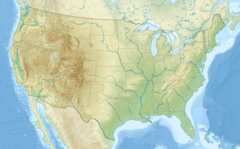World Center for Birds of Prey facts for kids

Panorama of World Center for Birds of Prey, May 2017
|
|
| Established | 1984 |
|---|---|
| Location | 5668 W. Flying Hawk Lane Boise, Idaho, U.S. |
| Visitors | 50,000 / yr. |
The World Center for Birds of Prey in Boise, Idaho, is a special place. It is the main office for The Peregrine Fund. This group started in 1970. They work to protect endangered raptors all over the world. Raptors are birds like eagles, hawks, and falcons.
The center was built in 1984. It sits on about 580 acres (2.3 square kilometers). This land is on a hilltop overlooking Boise. The campus has offices for The Peregrine Fund. It also has places to breed endangered raptors. You can visit the Velma Morrison Interpretive Center there. There is also the Herrick Collections Building. This building holds a large research library. It also has the Archives of Falconry.
The Peregrine Fund is famous for its work to save rare raptors. Their first big project was saving the peregrine falcon. This bird was almost gone because of a chemical called DDT. Thanks to their efforts, the peregrine falcon was taken off the U.S. Endangered Species list in 1999. This was a big celebration in Boise.
Contents
History of the Center
The Peregrine Fund first started breeding birds in 1970. This was at Cornell University in New York. They also had a facility in Fort Collins, Colorado in 1974. In 1984, they moved these efforts to Boise. This is when the World Center for Birds of Prey was created. Morley Nelson helped bring the group to his hometown of Boise. He was a well-known expert on raptors.
The first buildings at the new site were offices. There were also barns for the bird breeding program. In 1986, they built a special barn. It had climate control for tropical raptors. The Velma Morrison Interpretive Center opened in 1992. It had exhibits of rare raptors. It also offered interactive displays. They had programs for schools and other groups.
In 1993, they built the first barn for breeding California condors. The Herrick Collections Building opened in 2002. It has space for the research library. It also holds scientific collections. And it is home to the Archives of Falconry.
Helping Birds: Research and Breeding
The center has special facilities for research. These help make endangered birds healthy. They also help them reproduce and be released back into the wild. Scientists learn about how food, age, and the environment affect birds. They study how these things impact their health, growth, and how long they live. The breeding program was very important. It helped the peregrine falcon recover.
The center currently breeds two endangered birds. These are the California condor and the aplomado falcon. The condors are released in northern Arizona and southern Utah. Aplomado falcon chicks are released in Texas and New Mexico. Birds in the breeding facility are watched with video cameras. This helps scientists learn about their behavior. Studies on diseases, chemicals, food, and genes help biologists. They learn about problems facing birds in the wild.
Velma Morrison Interpretive Center: Meet the Birds
The Velma Morrison Interpretive Center opened in 1992. It helps people learn about raptors. The center has interactive displays. It also shows multi-media presentations. You can see live demonstrations with hawks, falcons, eagles, and owls. Visitors can even see a live California condor.
The center's education program has three parts. It teaches the general public. It also has programs for schools. And it does outreach events. All these programs use live raptors. They help teach people about protecting birds of prey and their homes. About 30,000 people visit the center each year. Velma Morrison (1920–2013) was important to the center. She was the wife of Harry Morrison. He helped start a big construction company.
Library and Archives: Learning About Raptors
The Herrick Collections Building was finished in 2002. It holds The Peregrine Fund's research library. It also has scientific collections. And it is home to the Archives of Falconry. The research library has over 20,000 books. It also has many journals, magazines, videos, and maps.
The library has an online service called the Global Raptor Information Network (GRIN). This service has information about hawks, eagles, and falcons. It connects raptor researchers around the world. It also shares new research and conservation news. The library's collections include over 13,000 eggshells. It also has nearly 300 bird study skins. Researchers use these for their work.
The Archives of Falconry has old falconry equipment. It also has artwork and notes. Falconry is an ancient sport of hunting with trained birds. The archives have 2,000 books on falconry. Some of these books are from 1495. The archives got much bigger in 2006. This was thanks to a donation from His Highness Sheikh Mohamed bin Zayed. He is from the United Arab Emirates. The new part of the building shows an authentic Arab tent. It also has items and displays about Middle Eastern falconry.


